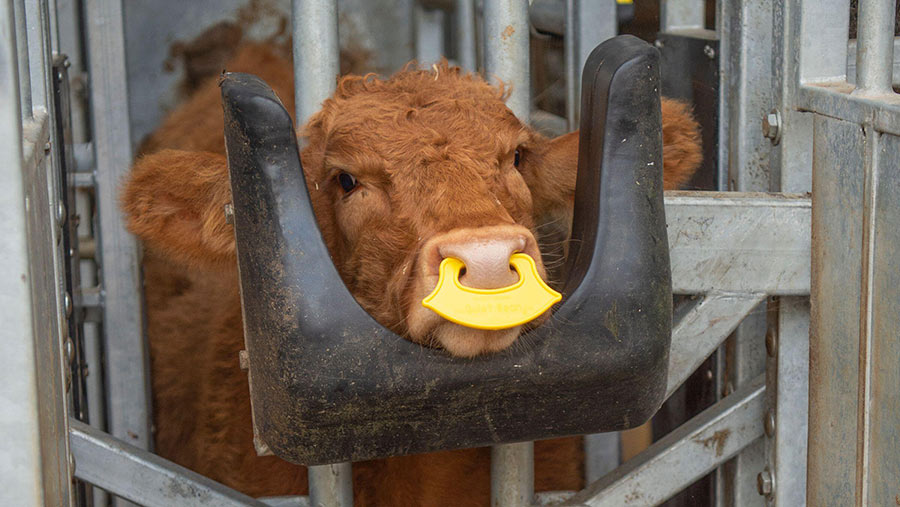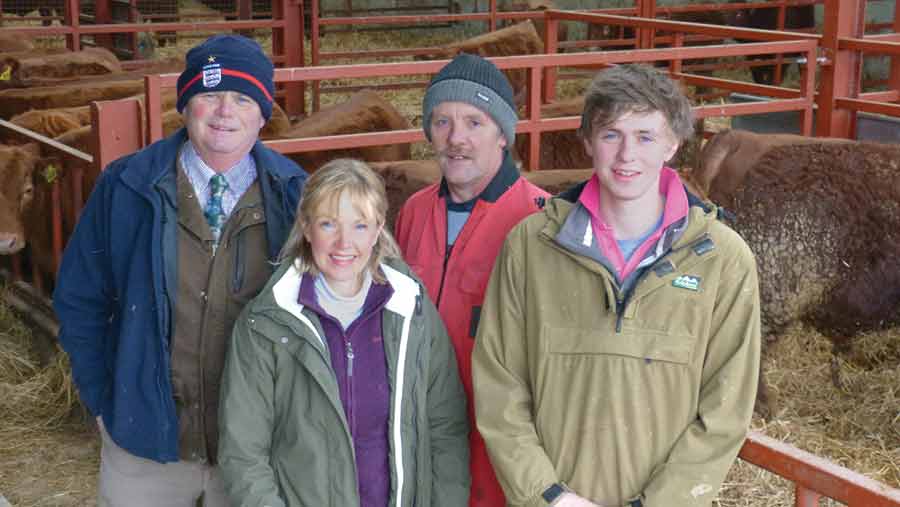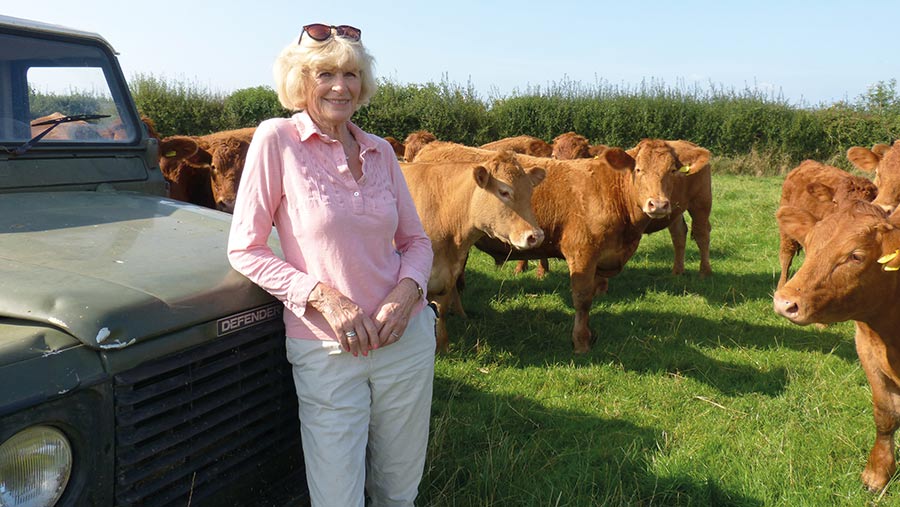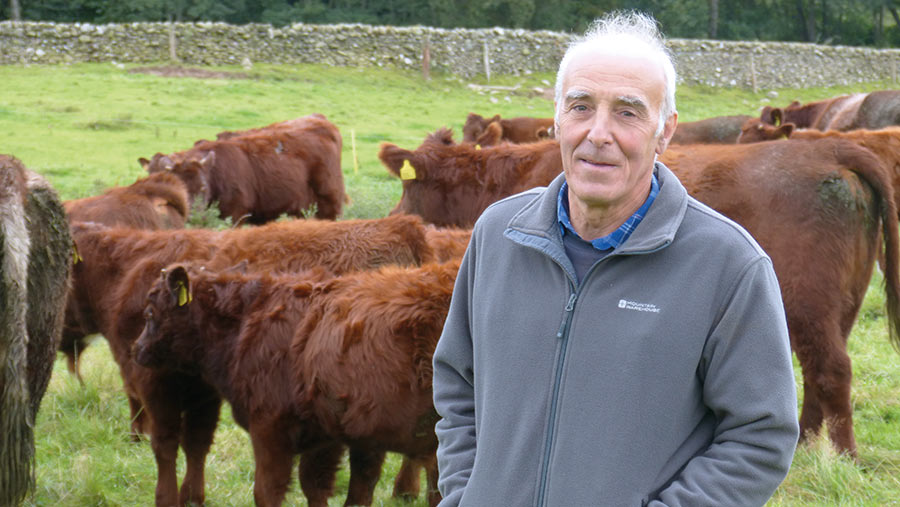3 weaning strategies explored for suckler farms
 © Farlap/Alamy Stock Photo
© Farlap/Alamy Stock Photo Many different strategies are employed by suckler herds across the UK to minimise stress, growth check and hassle when weaning suckler calves.
Scotland’s Rural College beef specialist Basil Lowman stresses that weaning is:
- The second most stressful time in a calf’s life (after birth)
- A compromise to the animal’s immune system, making it more susceptible to disease
- A major antagonist of liveweight gain in calves
- An opportunity to adjust dates to manage condition on leaner cows.
Farmers Weekly asks a forage-based suckler herd with a split-calving block, a mixed farm, and an organic rotational grazer in Scotland how they wean.
See also: Simple creep grazing system helps suckler cow efficiency
1. Creep feed and nose flaps: Sheppard family, Heightley, Shropshire

Heightley team © Heightley Farm
Separating heifers and bull calves, targeted creep feeding and nose flaps are used by Shropshire mixed farming family the Sheppards at Chirbury to ease calves into winter.
The Sheppards have creep-fed for decades, but started using nose flaps in 2015. Their Stabiliser herd produces finished bulls at 14 months of age and breeding stock.
Heightley Farm facts
- 130 cows to calve this year
- 2,000 Romneys and Exlana ewes
- Farms about 485ha on tenancies and grazing lets
- Grows 109ha of arable
- Rotation is wheat, barley, stubble turnips and maize for a dairy farmer
Bulls and heifers split
Cows calved from 20 February this year and bulls went in for nine weeks on 20 May.
Cows with bull calves and heifer calves are split and put in different paddocks when the breeding bulls are taken out at the end of July.
Bull calves are creep-fed from this point with a home-grown cereal mix.
It is made up of 70% barley, 10% wheat, 20% of a 34% protein balancer and a drop of molasses.
Tony Sheppard says: “The job of separating the calves is another thing to do and the cost of the barley and protein pellets must be factored in, but bull performance is good, reaching 365-370kg carcasses at an average of 14 months.
“By slaughter, they have had about 2t of concentrate and protein feed as well as ad-lib chopped grass silage.”
Heifers are creep-fed but receive smaller amounts, normally just to help them transition into the shed, where they may get supplemented.
The Sheppards find the heifers, which are bulled at 340-360kg to calve at two years old, grow well enough on just silage in the winter housing period.
However, because some customers prefer bigger, more filled-out heifers, some animals for sale are fed concentrate.
Nose flaps
Weaning flaps are inserted one week before housing, when pneumonia vaccinations are given.
Bulls are housed earlier, usually in October, and heifers are housed in November. Flaps are removed when calves are housed.
The flaps have reduced bawling by 80-90% and can last several years. However, they sometimes fall out and get lost and, at £5 a flap, this is another cost.
2. Creep gate: Charlotte Davis, Clapton Farm, Wincanton

Charlotte Davis © MAG/Michael Priestley
Weaning calves at 10-11 months old helps to avoid overfat cows and gently transitions calves to thrive on their own in a Somerset suckler herd.
Charlotte Davis has never fed concentrate or creep feed and manages without vaccinating for pneumonia due to the open, ventilated environment she weans and winters the calves in.
A combination of good-quality silage and easy-fleshing South Devon-cross cattle means overcondition could be a problem for the cows if weaning happened earlier, says Charlotte.
Half the herd calves in April and May and the rest calves from mid-August to mid-October.
“I am the only full-time person here, so it has to be simple,” she explains.
“Some older calves have practically weaned themselves. Calving difficulties are minimised by having cows in the right condition.”
Clapton Farm facts
- 110 commercial South Devon suckler cows
- Calves outdoors
- 147ha of grassland
- Farm is on an Agricultural Holdings Act tenancy
- Stores sold at 12-24 months at Salisbury Market
- l All cattle fed grazed grass, silage and minerals only
Both calving blocks are housed from early to-mid-November to coincide with the annual TB test. Spring and autumn calvers access self-feed silage in an outdoor clamp from a covered yard with straw bedding.
Calves (heifers and steers) can walk through a creep gate to a field, concrete pad and a straw-bedded Dutch barn to access grass and drier haylage (to avoid loose dung). Here they can spend time eating, sleeping and interacting away from their dam.
Spring calvers
After three months, spring-calving cows are removed from the yard into one next door, where the calves are still within earshot. After four or five days, when the bawling has calmed down, calves are turned out to spring grass.
Cows go out about a month later to calve outside.
Autumn calvers
Autumn calves are brought up to the yard in late July and separated from their dams.
On this day, the cows are taken up to the calving fields. Calves stay in a yard on silage for four to five days until they quieten down. The calves return to their original field to minimise change.
3. Fence-line wean: Giles and Stuart Henry, Oakwood Mill, Selkirk

Giles Henry © MAG/Michael Priestley
Fence-line weaning remains a constant for an organic Scottish spring-calving herd.
Giles Henry and his son, Stuart, will house weaned calves this year, rather than graze winter cover crops outside because climate change and drier conditions have made it too risky.
This winter, calves will be housed in a slatted shed on straw and mattress cubicles and fed red clover silage and ad-lib rock salt.
No pneumonia vaccines will be given.
Housing weaned cattle should lower their maintenance requirements, which the Henry family hope will lead to heavier cattle at turnout and help finish cattle before their expensive second winter.
Oakwood Mill Farm facts
- 65 pure Luings (Ettrick herd)
- Supplies Dovecote Park
- Tenant farmer on Buccleuch Estate
- 114ha of hill rented for outwintering
- Contract-finishes 47 Angus steers
Early start to weaning
Weaning starts when cattle are on the summer rotation of two- to three-day shifts on 1ha paddocks.
Calves fit under the single strand of electric wire to preferentially graze and explore away from their dams, decreasing the stress of the separation at weaning in October.
Fence-line separation
Calves average six months of age when weaned in mid-October, from an average calving date of 20 April in a tight six-week breeding period.
Weights typically average a 260kg calf from a 600kg cow.
Cows are moved to an adjacent field separated from their calves by a hedge and two strands of electric fence.
Stress is limited because the dams and calves can see and talk to each other, and the calf’s environment is unchanged.
Calves from the two bulling groups are mixed six days after weaning.
Bellowing (and attempts to cross the hedge) have usually subsided within three to five days, at which point the cows are walked to a local hill for wintering.
Calves continue grazing the rotation for a month or two, as conditions allow.
